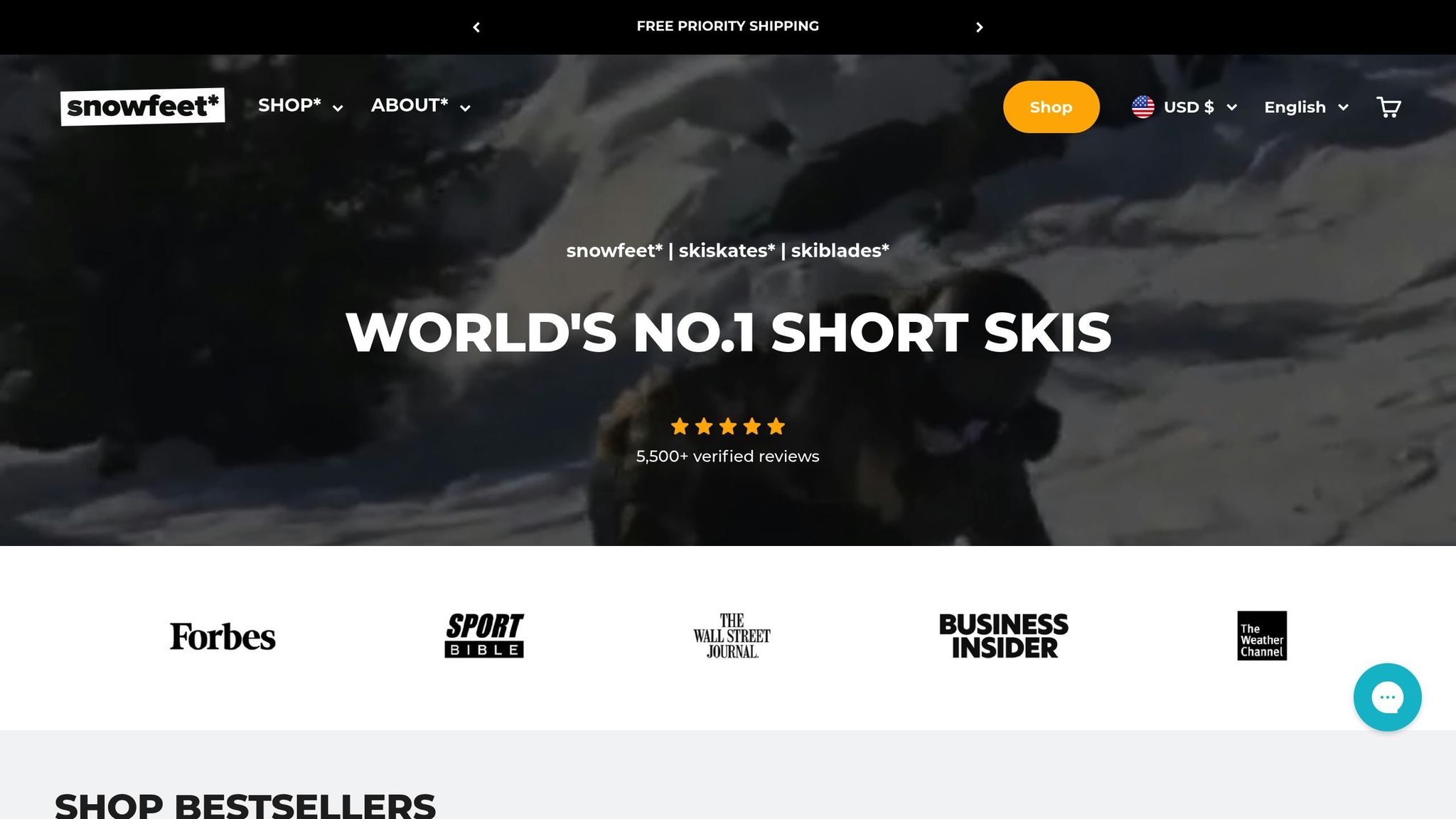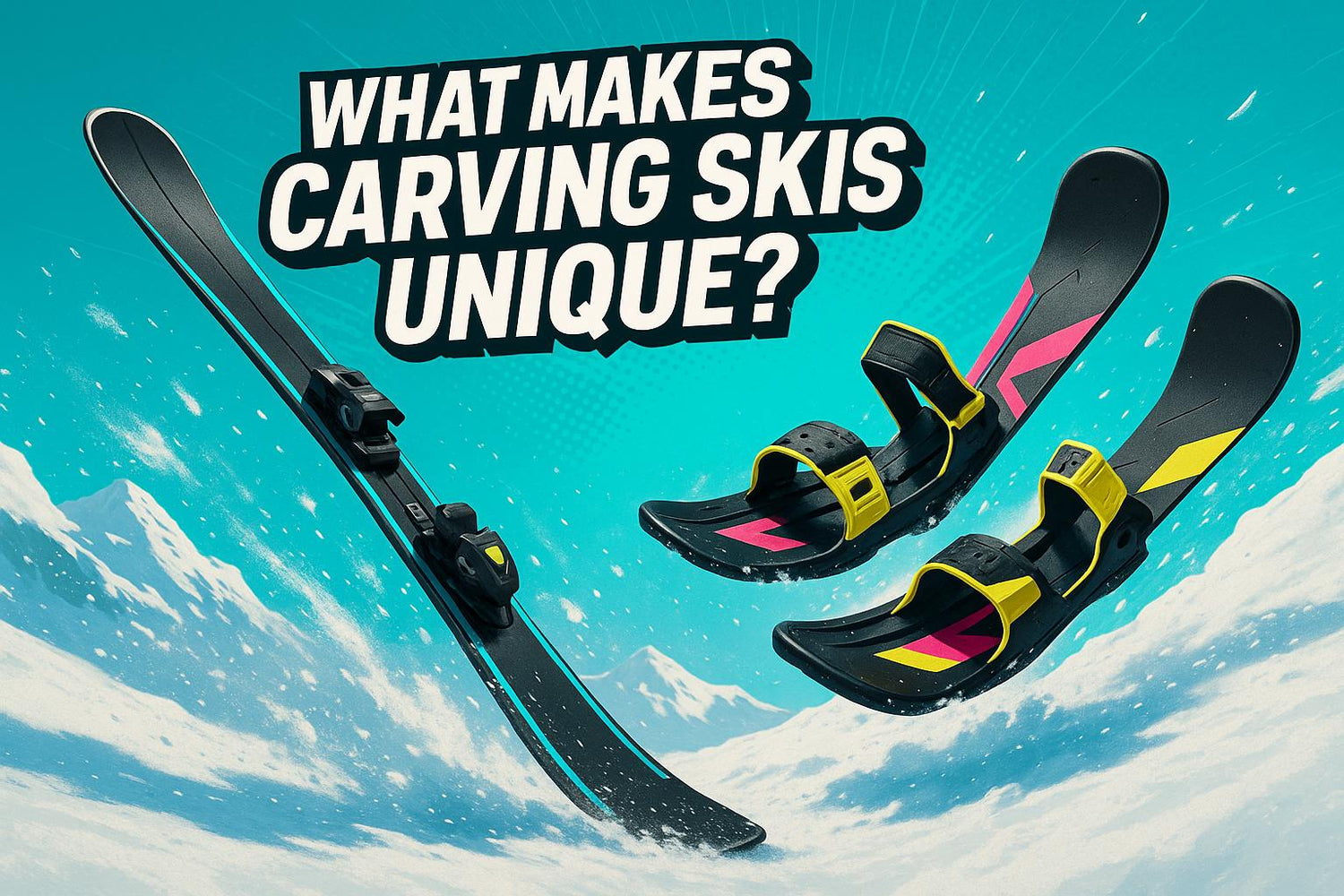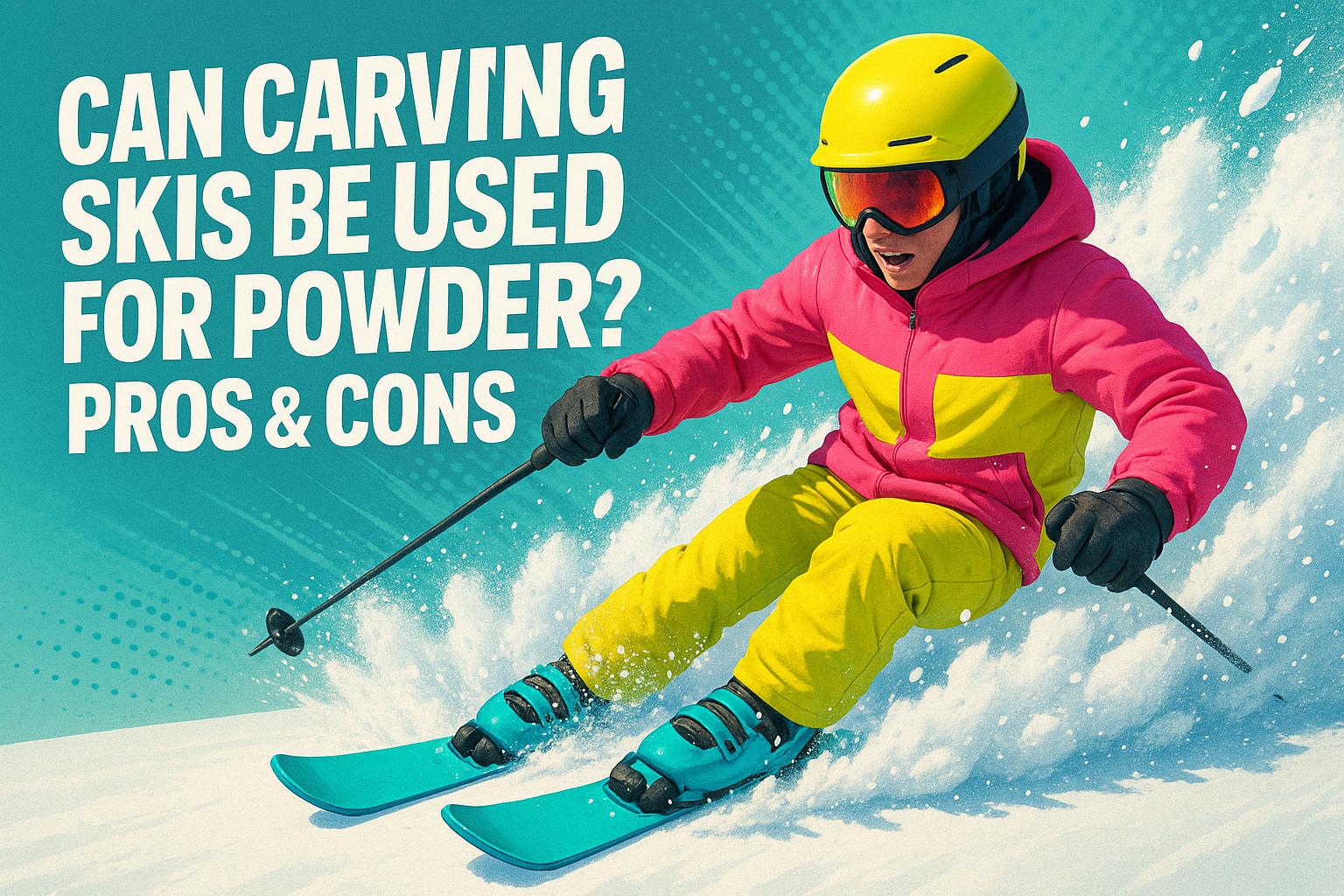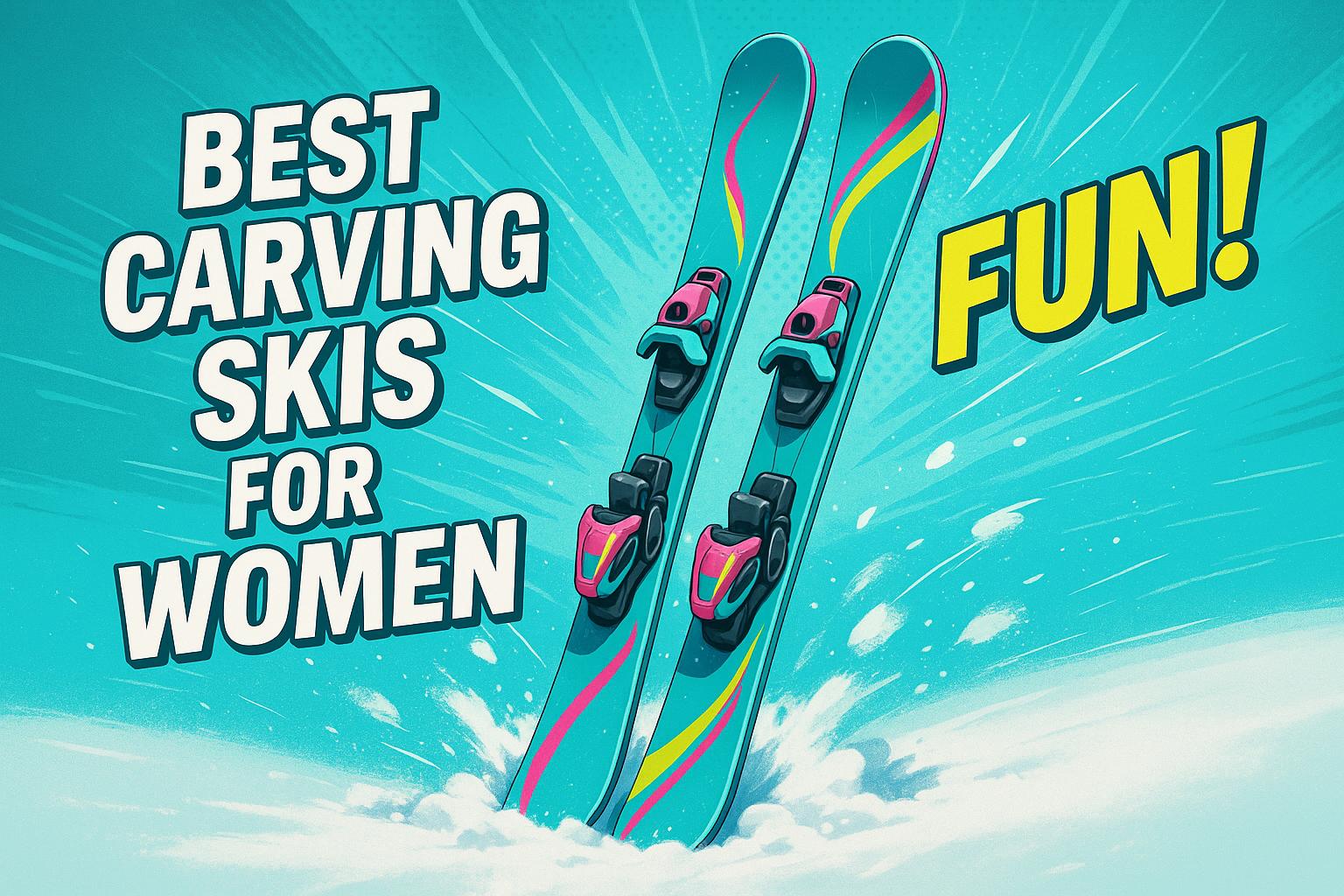Carving skis are all about precision and control on groomed slopes, while Snowfeet short skis focus on agility, portability, and ease of use. Here's the quick breakdown:
- Carving Skis: Designed for sharp, precise turns at high speeds. They have a narrow waist (65–80 mm) and a pronounced sidecut, making them ideal for intermediate to expert skiers on hard-packed snow. They require specialized boots and are less forgiving for beginners.
- Snowfeet Short Skis: Compact, lightweight, and beginner-friendly. They attach to regular winter boots or snowboard boots, making them super portable and easy to carry. Perfect for terrain parks, mixed snow conditions, and casual fun, but less stable at high speeds.
Quick Comparison:
| Feature | Carving Skis | Snowfeet Short Skis |
|---|---|---|
| Best For | Groomed slopes, high speed | Parks, trails, mixed snow |
| Length | Long (65–80 mm waist) | Short (38–120 cm) |
| Boots Needed | Specialized ski boots | Regular winter/snowboard |
| Skill Level | Intermediate to expert | Beginner to intermediate |
| Portability | Bulky, needs roof racks | Fits in a backpack |
| Terrain | Hard-packed snow | Versatile across terrains |
Carving skis are perfect if you're chasing speed and precision. Snowfeet short skis are a great pick for those who want a fun, portable option without the extra gear. Choose based on your style and goals!
1. Carving Skis
Design Features
Carving skis are designed with a narrow waist (65–80 mm) and a pronounced hourglass shape, which naturally flexes into an arc when the ski is edged. This dramatic sidecut is more pronounced than what you’d find in frontside skis.
These skis often feature heavier wood cores combined with reinforced metal elements, which add stability on groomed runs. Most carving skis stick to a traditional camber profile with little to no tip rocker. This design helps distribute weight more evenly, giving you better control during tight, precise turns.
All these elements work together to deliver quick edge transitions and excellent stability.
Performance Capabilities
Carving skis are built for performance on groomed runs. Their deep sidecut and stiff flex pattern allow for sharp edge grip and seamless, controlled turns on hard-packed snow.
"This ski is a race tool with no speed limit... It's a performance-oriented ski for ripping high-speed frontside arcs." - Dave Wolf, certified PSIA ski instructor and AMGA ski guide
These skis shine at higher speeds and on firm snow conditions. Their curved edges make it easy to change direction with just a tilt, eliminating the need for skidding turns. This creates a smoother, more controlled descent.
Versatility
Carving skis thrive on groomed terrain and hardpack but aren’t as adaptable in other conditions like moguls or mixed snow. Brands like Rossignol, Head, and Atomic produce traditional carving models that cater to advanced and expert skiers. These skis require precise technique to engage the edges properly, making them less forgiving for beginners.
"This is a precise, specialized tool that does not suffer fools... It's an exceptional, yet demanding ski for frontside-focused experts looking to lay tight arcs on hardpack and steep groomers." - Dave Wolf, mountain guide and ski instructor
While carving skis dominate hardpack, they’re not the go-to choice for varied conditions. Their design prioritizes precision and speed over versatility.
2. Snowfeet* Short Skis

Design Features
Snowfeet* short skis stand out with their compact design, ranging in size from 26 inches (65 cm) to 55 inches (140 cm). Unlike traditional skis that require specialized boots, these attach directly to your everyday winter boots, snowboard boots, or ski boots. This makes getting ready for the slopes quick and hassle-free.
The design combines elements of skiing and skating, offering a responsive and agile feel while maintaining enough stability for control. Premium models like the Skiskates, built with a wood core, provide durability without the weight of bulkier skis. This thoughtful construction ensures a smooth and reliable performance on the slopes.
Performance Capabilities
Snowfeet* short skis shine when it comes to versatility. Their smaller size makes it easy to execute quick turns and sharp direction changes, even on challenging terrain. This agility is a game-changer in tight spaces or crowded slopes, making these skis perfect for terrain parks, moguls, and mixed-condition runs. While they may not match the high-speed stability of longer skis, their forgiving nature makes them a great choice for beginners and intermediate skiers looking to improve their skills.
Versatility
These skis aren’t just about agility - they’re built to handle a variety of conditions. While many ski brands focus on groomed runs, Snowfeet* are designed for everything from terrain parks to backcountry trails. Specialized options, like the POWDER model, even tackle deep, powdery snow with ease. Whether you’re a seasoned skier or just starting out, Snowfeet* open up opportunities to try new tricks and explore different terrains without feeling limited.
Portability
One of the biggest perks of Snowfeet* short skis is how easy they are to carry around. Traditional skis can be a hassle - think roof racks, extra luggage fees, and finding storage space. Snowfeet*, on the other hand, are compact and lightweight enough to fit in a standard backpack. Whether you’re tossing them in your car trunk, storing them in a closet, or taking them along on a trip, their portability makes your winter adventures that much simpler.
HOW TO CARVE on Skis - Advanced Ski Lesson #6.2 - Carving
sbb-itb-17ade95
Pros and Cons
Let’s break down the strengths and weaknesses of carving skis and Snowfeet* short skis to help you decide which one fits your skiing style and goals.
Carving skis are all about precision and control, especially on groomed slopes. As SkiMag.com describes:
"There's nothing like the feeling of two sets of edges connecting with fresh corduroy in arc after arc, leaving railroad tracks behind you - like an artist signing their name on a canvas. That's the rush carving skis can offer."
But this laser focus on performance has its downsides. Carving skis are longer and heavier, making them harder to maneuver in tight spots and a bit of a hassle to transport.
On the flip side, Snowfeet* short skis take a different route, emphasizing versatility and ease of use. While they don’t match carving skis for high-speed stability, they shine in other areas. You can strap them onto the winter boots you already own, toss them in a backpack, and take them almost anywhere - slopes, terrain parks, or even hiking trails. They’re lightweight, portable, and perfect for exploring a variety of terrains.
Skill level matters here, too. Carving skis are typically better suited for advanced or expert skiers who know how to carve turns effectively. Snowfeet*, however, are beginner-friendly, making them a great option for those just starting out or looking to gain confidence on the snow.
Cost and complexity are another area where these two options differ. Carving skis often require specialized boots, bindings, and professional mounting services, which can add up quickly. Brands like Rossignol, Atomic, and Head are known for their high-performance carving skis, but they come with these extra requirements. Snowfeet*, on the other hand, keep things simple. They work with regular winter shoes or snowboard boots, cutting out the need for additional gear and saving you time and money.
| Feature | Carving Skis | Snowfeet* Short Skis |
|---|---|---|
| Best For | Groomed slopes, precise carving turns | Slopes, terrain parks, hiking trails, skating |
| Construction | Wood core | Durable plastic |
| Length | Long | Very short (e.g., around 44 cm / 17 inches) |
| Boot Requirements | Specialized ski boots | Regular winter shoes or snowboard boots |
| Skill Level | Advanced to expert | Beginner-friendly |
| Portability | Requires roof racks or ski bags | Fits in a backpack |
| Terrain Versatility | Optimized for groomed runs | Suitable for slopes, parks, and trails |
| Speed Stability | Stable at high speeds | Prioritizes maneuverability |
Another key difference is how they handle various snow conditions. Carving skis, with their narrower 70–80 mm waist widths, are built for hardpack and groomed snow. Snowfeet*, especially models like the POWDER version, are more adaptable. They can handle everything from groomed runs to deeper snow, making them a solid choice when the weather throws you a curveball.
In short, Snowfeet* short skis offer a fresh take on skiing, focusing on convenience, versatility, and fun. While carving skis deliver unmatched performance for groomed slopes and expert skiers, Snowfeet* provide an exciting alternative for those who value portability and easy access to a variety of terrains. Whether you’re looking for high-speed thrills or a more laid-back, adventurous experience, there’s an option for everyone.
Conclusion
Carving skis are the go-to for advanced skiers who crave precision and stability at high speeds on groomed runs. Brands like Rossignol, Atomic, and Head have mastered this design, making them a staple for those seeking top-tier performance.
On the flip side, Snowfeet* short skis are shaking things up by focusing on simplicity and versatility. As one happy user, Jakub F, shares:
"With these little skis, you feel much more agile, faster, and above all – comfortable. No buckles, no heavy boots – just strap in and go."
What makes Snowfeet* stand out? Their ease of use and portability. You can use them with your regular winter boots, and they’re compact enough to fit in a backpack. Some models are as short as 17 inches (44 cm), giving you a skating-like experience that’s both fun and practical.
Cost is another factor to consider. Traditional carving skis come with added expenses - specialized boots, bindings, and professional mounting that can quickly rack up the bill. Snowfeet* eliminate these hurdles, offering a straightforward, beginner-friendly option. As Niels Staal puts it:
"It is truly the best of both worlds. Comfort for our feet and still being able to ski. [...] Nice and mobile, comfortable and it's truly a lot of fun. I can seriously recommend them to anyone."
Snowfeet* also challenge the idea that longer skis are always better. Their philosophy? Smaller skis can create a more enjoyable and accessible skiing experience. With options ranging from 38 cm mini ski skates to 120 cm short skis, there’s something for every skill level.
If you’re a skilled skier looking for unmatched carving performance, traditional skis are still the way to go. But if you’re after freedom, versatility, and the ability to hit the slopes with minimal gear, Snowfeet* short skis offer a fresh, modern alternative that’s changing the game. Whether you prioritize precision or playful versatility, the choice is yours.
FAQs
How do carving skis compare to Snowfeet short skis in design and performance?
Carving skis are typically longer, ranging from about 59 to 71 inches (150–180 cm). They’re built for stability at high speeds, smooth, precise turns, and excellent edge grip on groomed slopes. The design focuses on torsional stiffness, which makes them a favorite for advanced skiers who love fast, controlled carving.
On the other hand, Snowfeet short skis are much smaller, measuring just 15 to 47 inches. They’re lightweight, super maneuverable, and perfect for quick, tight turns without much effort. Their compact size also makes them easy to carry around. Snowfeet are great for beginners and casual skiers, offering a fun and accessible way to hit the slopes. While carving skis shine in speed and stability, Snowfeet bring a playful twist with their agility and portability - offering a fresh take on traditional skiing gear.
How are Snowfeet short skis beginner-friendly compared to traditional carving skis?
Snowfeet short skis are a great choice for beginners. Their compact and lightweight design makes them much easier to handle compared to traditional carving skis. The shorter length takes away some of the intimidation that comes with longer skis, boosting confidence and making new skiers feel more at ease on the slopes.
Unlike traditional skis from well-known brands like Rossignol or Atomic, Snowfeet skis are designed to be more forgiving and beginner-friendly. This means they help new skiers pick up essential skills more quickly while offering a fun and safe way to dive into the world of skiing.
How are Snowfeet short skis more portable than traditional carving skis, and what does this mean for their performance on different terrains?
Snowfeet short skis stand out for their portability, thanks to their compact size - usually under 5 feet long. This small, lightweight design means you can toss them into a backpack without breaking a sweat. Forget about dealing with bulky roof racks or oversized ski bags; these skis make getting to the slopes or hiking to remote spots a breeze.
Their compact build isn't just about convenience - it also makes them super versatile. Whether you're gliding along cross-country trails, hitting terrain parks, or exploring off-piste areas, Snowfeet short skis handle it all with ease. Their lightweight design lets you switch terrains quickly and maneuver effortlessly, offering a fun and accessible skiing experience without compromising control or performance.


































Leave a comment
This site is protected by hCaptcha and the hCaptcha Privacy Policy and Terms of Service apply.